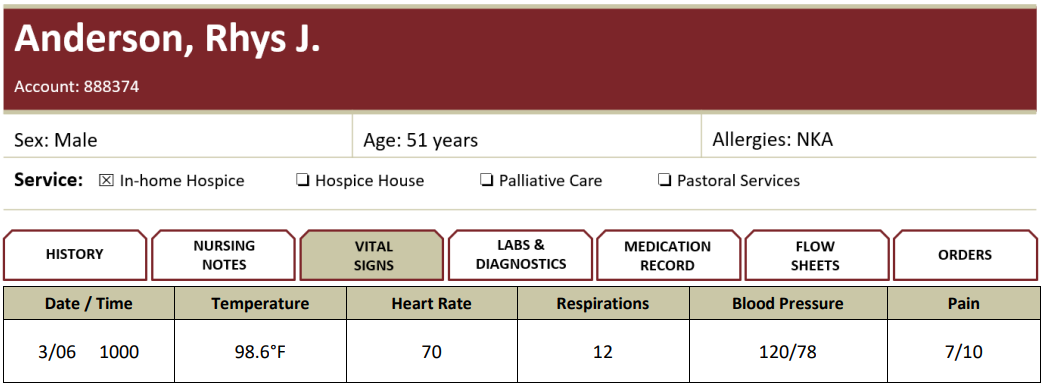4.3.1: FRAME 1- Recognize Cues
- Page ID
- 90021
\( \newcommand{\vecs}[1]{\overset { \scriptstyle \rightharpoonup} {\mathbf{#1}} } \)
\( \newcommand{\vecd}[1]{\overset{-\!-\!\rightharpoonup}{\vphantom{a}\smash {#1}}} \)
\( \newcommand{\id}{\mathrm{id}}\) \( \newcommand{\Span}{\mathrm{span}}\)
( \newcommand{\kernel}{\mathrm{null}\,}\) \( \newcommand{\range}{\mathrm{range}\,}\)
\( \newcommand{\RealPart}{\mathrm{Re}}\) \( \newcommand{\ImaginaryPart}{\mathrm{Im}}\)
\( \newcommand{\Argument}{\mathrm{Arg}}\) \( \newcommand{\norm}[1]{\| #1 \|}\)
\( \newcommand{\inner}[2]{\langle #1, #2 \rangle}\)
\( \newcommand{\Span}{\mathrm{span}}\)
\( \newcommand{\id}{\mathrm{id}}\)
\( \newcommand{\Span}{\mathrm{span}}\)
\( \newcommand{\kernel}{\mathrm{null}\,}\)
\( \newcommand{\range}{\mathrm{range}\,}\)
\( \newcommand{\RealPart}{\mathrm{Re}}\)
\( \newcommand{\ImaginaryPart}{\mathrm{Im}}\)
\( \newcommand{\Argument}{\mathrm{Arg}}\)
\( \newcommand{\norm}[1]{\| #1 \|}\)
\( \newcommand{\inner}[2]{\langle #1, #2 \rangle}\)
\( \newcommand{\Span}{\mathrm{span}}\) \( \newcommand{\AA}{\unicode[.8,0]{x212B}}\)
\( \newcommand{\vectorA}[1]{\vec{#1}} % arrow\)
\( \newcommand{\vectorAt}[1]{\vec{\text{#1}}} % arrow\)
\( \newcommand{\vectorB}[1]{\overset { \scriptstyle \rightharpoonup} {\mathbf{#1}} } \)
\( \newcommand{\vectorC}[1]{\textbf{#1}} \)
\( \newcommand{\vectorD}[1]{\overrightarrow{#1}} \)
\( \newcommand{\vectorDt}[1]{\overrightarrow{\text{#1}}} \)
\( \newcommand{\vectE}[1]{\overset{-\!-\!\rightharpoonup}{\vphantom{a}\smash{\mathbf {#1}}}} \)
\( \newcommand{\vecs}[1]{\overset { \scriptstyle \rightharpoonup} {\mathbf{#1}} } \)
\( \newcommand{\vecd}[1]{\overset{-\!-\!\rightharpoonup}{\vphantom{a}\smash {#1}}} \)
Rhys Anderson is a 51-year-old male who was diagnosed with Stage IV pancreatic ductal adenocarcinoma 11 months ago. Rhys’s condition has rapidly declined over the past 6-8 weeks. The hospice nurse is conducting an initial visit for Rhys in his home. The nurse reviews the client’s history, medications, and vital signs.




QUESTION: Matrix Multiple Choice
Scoring Rule: 0/1
What symptoms are associated with pancreatic cancer?
Each row should include a single choice.
| Symptom | Associated | Not Associated |
|---|---|---|
| Nausea | ||
| Confusion | ||
| Bloating | ||
| Fatigue | ||
| Edema | ||
| Icterus (Jaundice) | ||
| Sudden onset of diabetes | ||
| Light colored stools | ||
| Dark colored urine |
Putting It All Together
DEBRIEF
Pancreatic cancer affects your pancreas, a gland in your abdomen that aids in digestion. Early stages of pancreatic cancer often have no symptoms; however, if symptoms are present, they can include nausea, bloating, fatigue, jaundice, lack of appetite, stomach pain, back pain, sudden onset of diabetes, light-colored stool, and dark-colored urine.
Pancreatic cancer survival rates are low because the disease is difficult to detect in the early stages (Cleveland Clinic, 2023). The most common type of pancreatic cancer is ductal adenocarcinoma, which begins in the cells that line your organs. Pancreatic ductal adenocarcinoma is poised to become the second leading cause of cancer-related death by 2030, and the median overall survival for clients with advanced, metastatic disease remains only about 12 months (Pishvaian et al., 2020). Treatment for pancreatic cancer includes surgery, chemotherapy, and radiation therapy.
Early stages of pancreatic cancer often do not have symptoms. Jaundice or icterus is one of the first symptoms of pancreatic cancer. Jaundice generally manifests first in the sclerae and/or mucous membranes and skin.
RECOGNIZING SOCIAL DETERMINANTS OF HEALTH (SDOH)
This case study focuses on an individual with Stage IV pancreatic cancer and addresses two of the five SDOH domains: Health Care Access and Quality and Social and Community Context. The goal for the SDOH domain, Health Care Access and Quality, is to increase access to comprehensive, high-quality healthcare services (Healthy People, 2030).
Rhys’s therapy was discontinued by his oncologist due to the limited response from numerous treatment approaches. Despite discontinuing his cancer treatments, Rhys receives comprehensive, quality end-of-life care from the home health/hospice care team. Health Care Access and Quality also includes involving clients in healthcare decisions as much as the client desires (HC/HIT-03).
What Do You Think About?
- What part of the body frequently develops jaundice first?
- Describe and differentiate how the nurse assesses the sclerae, mucous membranes, and skin for jaundice?
- How does assessment for jaundice differ in a client with darker skin tone compared to a client with a lighter skin tone?
- What chemical compound causes jaundice?


